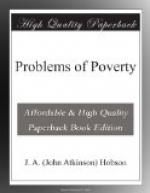Furring employs large numbers of foreign males, and some thousands of both native and foreign females. It is almost entirely conducted in small workshops, under the conduct of middlemen, who receive the expensive furs from manufacturers, and hire “hands” to sew and work them up. Wages have fallen during the last few years to the barest subsistence point, and even below. Wages for men are put at 10s. or 12s., and in the case of girls and young women, fall as low as 4s.; a sum which is in itself insufficient to support life, and must therefore be only paid to women and girls who are partly subsisted by the efforts of relatives with whom they live, or by the wages of vice.
In cabinet-making and upholstery, the same disintegrating influences have been at work which we noted in tailoring. Many firms which formerly executed all orders on their own premises, now buy from small factors, and much of the lowest and least skilled work is undertaken by small “garret-masters,” or even by single workmen who hawk round their wares for sale on their own account. The higher and skilled branches are protected by trade organizations, and there is no evidence that wages have fallen; but in the less skilled work, owing perhaps in part to the competition of machinery, prices have fallen, and wages are low. There is evidence that the sub-contract system here is sometimes carried through several stages, much to the detriment of the workman who actually executes the orders.
One of the most degraded among the sweating industries in the country is chain and nail-making. The condition of the chain-makers of Cradley Heath has called forth much public attention. The system of employment is a somewhat complicated one. A middleman, called a “fogger,” acts as a go-between, receiving the material from the master, distributing it among the workers, and collecting the finished product. Evidence before the Committee shows that an accumulation of intricate forms of abuse of power existed, including in some cases systematic evasion of the Truck Act. Much of the work is extremely laborious, hours are long, twelve hours forming an ordinary day, and the wage paid is the barest subsistence wage. Much of the work done by women is quite unfit for them.
Sec. 5. Who is the Sweater? The Sub-contractor?—These facts relating to a few of the principal trades in the lower branches of which “sweating” thrives, must suffice as a general indication of the character of the disease as it infests the inferior strata of almost all industries.
Having learnt what “sweating” means, our next question naturally takes the form, Who is the sweater? Who is the person responsible for this state of things? John Bull is concrete, materialistic in his feeling and his reasoning. He wants to find an individual, or a class embodiment of sweating. If he can find the sweater, he is prepared to loathe and abolish him. Our indignation and humanitarianism




